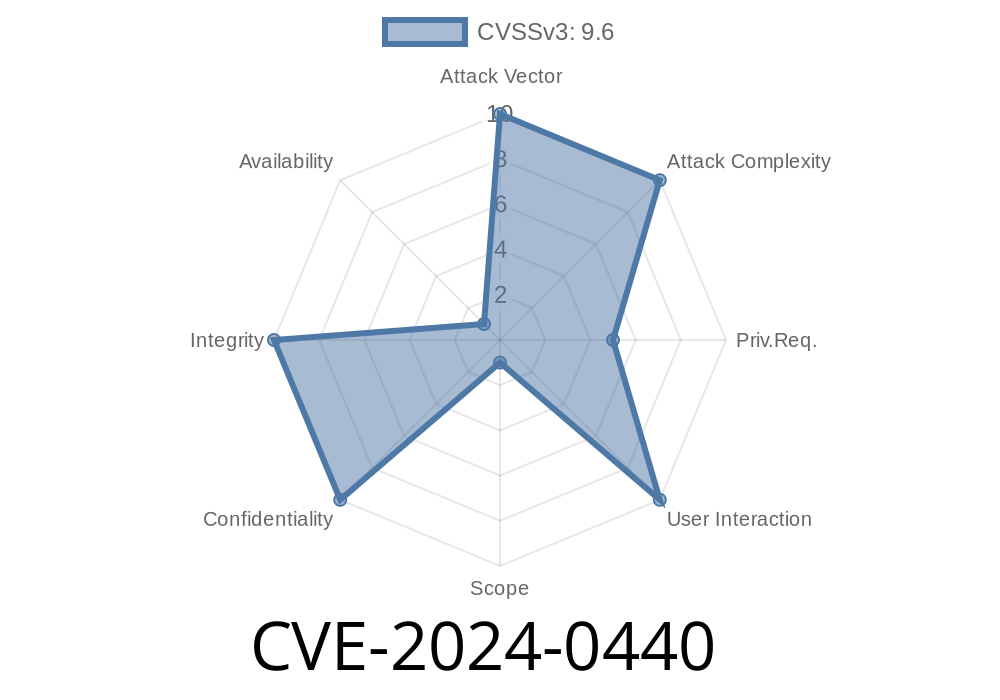Recently, a new vulnerability has been identified, and it has been assigned the code CVE-2024-0440. In simple terms, this vulnerability allows an attacker who has permission to submit a link, or submits a link via POST to a web application, to use the file:// protocol and gain access to host files and other relatively stored files. This post aims to break down the details of this vulnerability, explain its potential impact, and provide some useful resources and references for addressing it.
Exploit Details
The main crux of this vulnerability lies in the fact that when an attacker is able to submit a link using the file:// protocol, they can essentially access and read host files and other relative files on the victim's system. This is extremely dangerous as it gives the attacker the ability to access sensitive information, manipulate files, and wreak havoc on the targeted system.
For example, consider a simple web application that allows users to submit links to be collected and displayed:
from flask import Flask, request
app = Flask(__name__)
@app.route('/', methods=['POST'])
def collect_links():
link = request.form['link']
# ... link collection and storage logic ...
return 'Link submitted successfully.'
if __name__ == '__main__':
app.run()
In this case, an attacker could tailor their payload using the file:// protocol to access host files
POST / HTTP/1.1
Host: webapp.example.com
Content-Type: application/x-www-form-urlencoded
Content-Length: ...
link=file:///etc/passwd
Upon successful execution of the exploit, the attacker would gain access to the contents of /etc/passwd or any other specified file.
Original References and Resources
- MITRE's CVE-2024-0440 Reference: Provides a brief overview of the vulnerability, as well as affected versions and platforms.
- NVD's CVE-2024-0440 Reference: Offers additional vulnerability information, including a detailed description, CVSS score and vector, and known affected software.
- OWASP's Unvalidated Redirects and Forwards: Presents a comprehensive guide to protecting your web applications against unvalidated redirects and forwards, in addition to discussing how to prevent similar exploitation of the file:// protocol.
Mitigation and Prevention
To prevent exploitation of this vulnerability in your web applications, you should take the following steps:
1. Validate and sanitize all user input: This is a fundamental security concept, and it is especially relevant in this case. Ensure that any incoming links or data are properly validated and sanitized to prevent unexpected or malicious input.
2. Restrict the use of the file:// protocol and other potentially dangerous protocols in your applications: You may also consider implementing a URL filtering mechanism that prevents the use of unauthorized protocols (e.g., only allowing http and https).
3. Apply security best practices when handling user-provided URLs: Always follow well-established security practices (such as the ones listed in the OWASP resource linked above) when working with URLs provided by users.
Conclusion
CVE-2024-0440 is a serious vulnerability with potentially severe consequences if left unaddressed. To protect your systems from attackers leveraging this exploit, you should be diligent in validating and sanitizing all user input and thoroughly follow security best practices when working with URLs and user-provided data. Stay informed about the latest developments in cybersecurity and always prioritize securing your systems and applications.
Timeline
Published on: 02/26/2024 16:27:50 UTC
Last modified on: 02/26/2024 16:32:25 UTC
